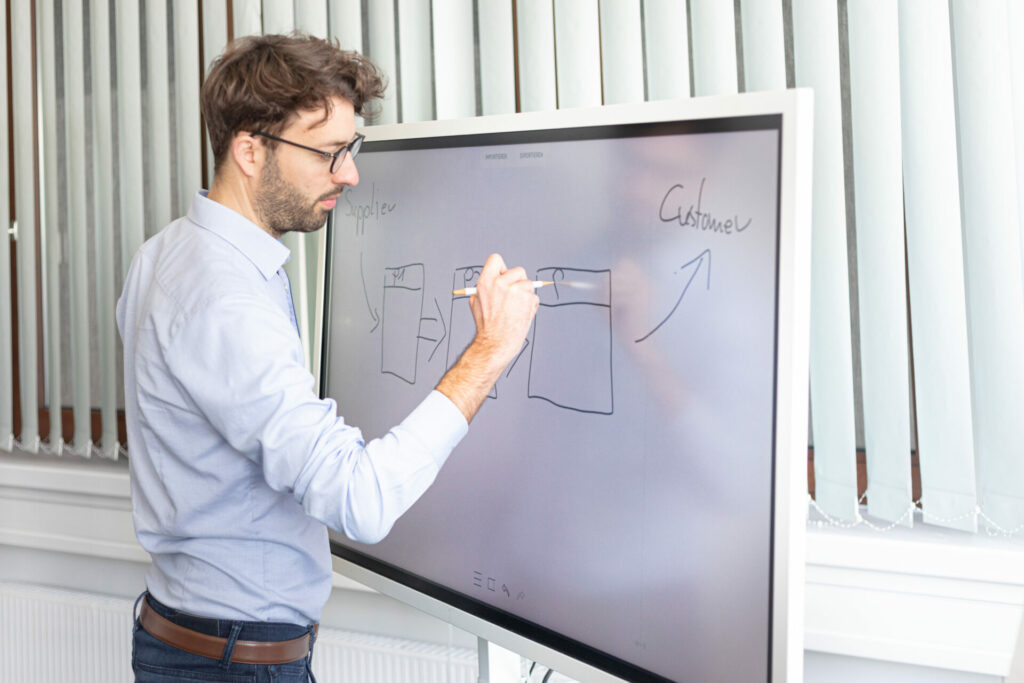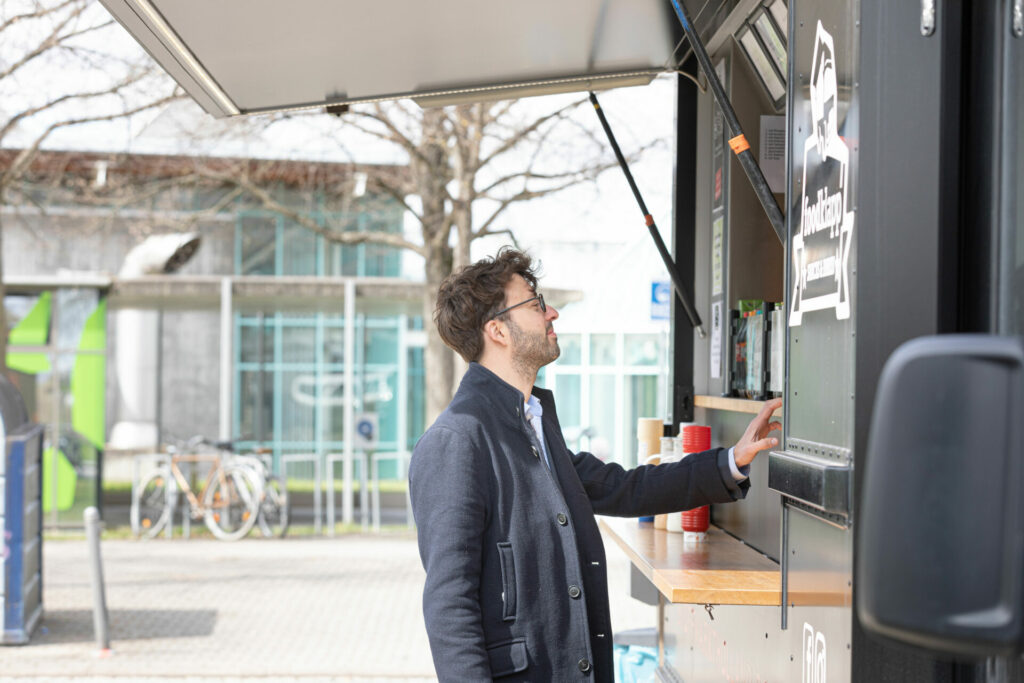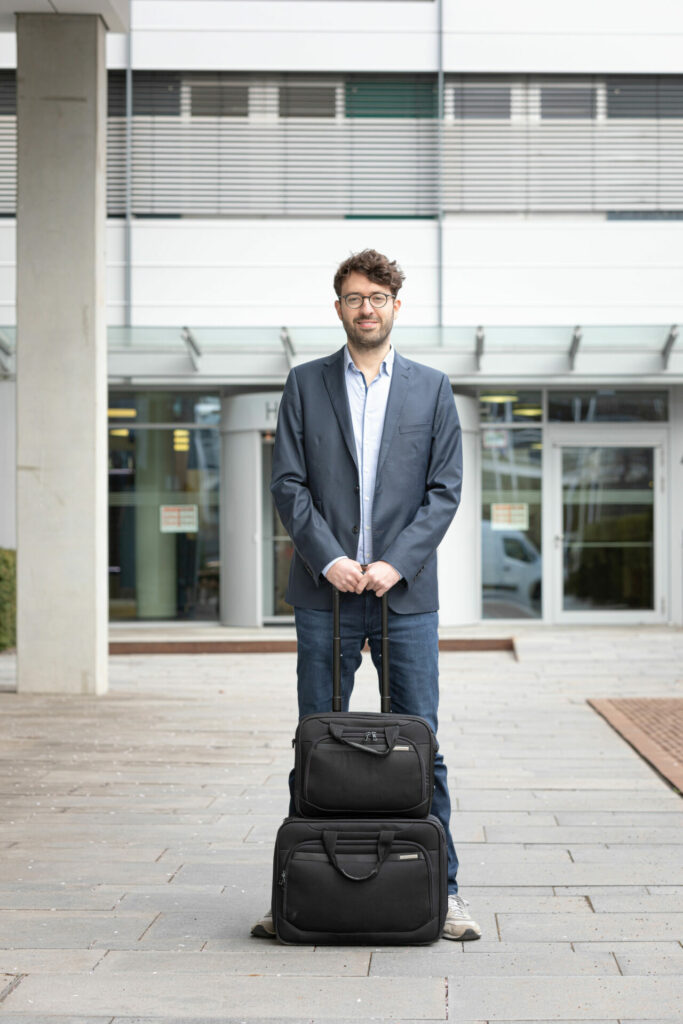Source: Fraunhofer IPA/Photo: Rainer Bez
A day with... Markus Böhm
He started his career as a factory planner almost ten years ago in Iceland. Today, Markus Böhm is developing value stream analysis at Fraunhofer IPA and transferring it to the digital age. “interaktiv” has accompanied the researcher for a day and presents him and his work.
Published on 2024-01-18
Reading time about 7 minutes
Markus Böhm came to the factory planning rather by chance. He had come to Reykjavík for a year abroad to complete his mechanical engineering studies and gain his first experience in professional life. At the Karlsruhe Institute of Technology, Böhm had previously specialized in medical technology and theoretical mechanical engineering. Using mathematical models at a company in the Icelandic capital, he now predicted how the carbon fiber-reinforced components in personalized leg prostheses would behave under load.
But then a former warehouse was to be rebuilt to be able to assemble medical technology products in it. The project manager fell out and Böhm jumped in. He determined the space requirements of the individual assembly stations and assigned them seats in the hall. He directed a staff of craftsmen to set up the hall according to his plans. In the end, he supervised the run-up to see if everything worked smoothly – and apparently licked blood.
Value stream analysis with clipboard and stopwatch
Böhm returned to Germany and took up a position as a scientific assistant in the department of factory planning and production management at Fraunhofer Institute for Manufacturing Engineering and Automation IPA in December 2014. “I wanted to go back to research, catch up on my doctoral thesis,” says Böhm looking back. “The mixture of scientific work and practical implementation in industry attracted me.”
Podcast on the digitalization of value stream analysis
Markus Böhm and his project partner Jörg Drees, founder of Stuttgart-based software provider iFAKT GmbH, explain how value stream analysis is being transferred to the digital age in episode 10 of “Interactive – The Fraunhofer IPA Podcast”.
Listen to it now: https://spoti.fi/3B4ZzLO
At Fraunhofer IPA, factories are planned in a value stream-oriented manner. The main focus is therefore on lean production processes and optimal area utilization. The most important tool is value stream analysis. An external service provider or an internal planning engineer with a terminal board and stopwatch steps past all the production stations, interviews employees and measures how long each work step takes. From these notes, an overall overview is then created by hand, which shows the interplay of all production processes on a DIN A3 sheet. Only when the actual state of production is known down to the last detail does it become clear at which points the processes can be optimized.
“In this classical form, value stream analysis is nothing more than a snapshot,” says Böhm, “and most companies carry it out once a year at most.” But the production system often changes several times over the course of a year: New products are manufactured, different raw materials are processed than before, and perhaps additional machines are purchased. Potential for optimization therefore remains undetected for a long time.






The plan: Bring value stream analysis into the digital age
Böhm was already annoyed during his schooldays when he was working in a locksmith’s workshop during the summer holidays about sentences such as “we have always done that this way” or “we have never done that like this before”. “Why do you stick to traditional structures when it is obvious that things are going better?” he asks. In modern production systems, classical value stream analysis is an old-fashioned structure for him. It has been the same for more than 40 years and is still profoundly analog today. Böhm wants to bring it into the digital age. In the future, he would like to continuously analyze the value streams in a factory and evaluate the production data from the Manufacturing Execution System (MES) and Enterprise Resource Planning (ERP).
However, such databases are often inaccurate or incomplete. This means that there is a lack of data that is important for value stream analysis. Böhm also evaluates machine data – and struggles with heterogeneous interfaces: Incompatible hardware, manufacturer-specific programming languages, different file formats. In many cases, the machines are designed in such a way that only the manufacturer has access to the data.
Böhm often cannot access the machine data or read it out. So he procures them in a different way: via sensors. Böhm’s research team, for example, attaches location sensors to small load carriers and can then track in real time which stations a customer job is going through in assembly and how long it is being processed there.
The goal: Value stream analysis is intended to record working conditions
Böhm does the conceptual part of his work and programming in his office in Stuttgart or in his home office. He regularly travels to Vienna for the practical part. Together with colleagues from Fraunhofer Austria, he uses the pilot factory of the Technical University. Together with colleagues from Vienna and Stuttgart, Böhm wants to increase the speed of installation of his digital value stream analysis and evaluate larger amounts of data than before. In the future, the researchers would like to record working conditions in assembly. Unfavorable lighting conditions or noise also have a negative effect on productivity.
But Böhm seems to be very satisfied with his own working conditions. Fraunhofer Austria is based in the city center of Vienna, not far from Belvedere Palace. “That’s where others go on holiday,” says Böhm. Sometimes he does not fly back to Stuttgart on Friday evening, but rather hangs on the weekend and explores Vienna.
But his real passion is hiking in mountains. Böhm loves high mountains and for this he likes to take faraway trips. He has already explored the Kibo in Tanzania on foot and also the Great Caucasus in Russia. Perhaps his preference for high mountains stems from the fact that Böhm comes from the Unterallgäu and he was able to see the Alps on the horizon on clear days during his youth. For jogging, the “Swabian plain”, as he calls it, is just good enough for him.
Contact
Tim Teriete
Member of the Factory Planning and Value Stream Design research team
Phone: +49 711 970-1210
